
Welcome to the magical fantasy world of Lytharia. A world full of expansive natural beauty but also full of strife and savagery. The inhabitants range from the organized city states of the humanoid races to the primitive clans of tribal monsters. Beasts of all descriptions roam the varied and spectacular terrain of Lytharia. The fight between good and evil is an ever present struggle and the power of the arcane and the elements fuel these battles. The journey begins with the inhabitants of Jangor that include the Brudakian, Deepdark, Kevetni, Stoneborn, Surictavi and Zuk Gar clans.

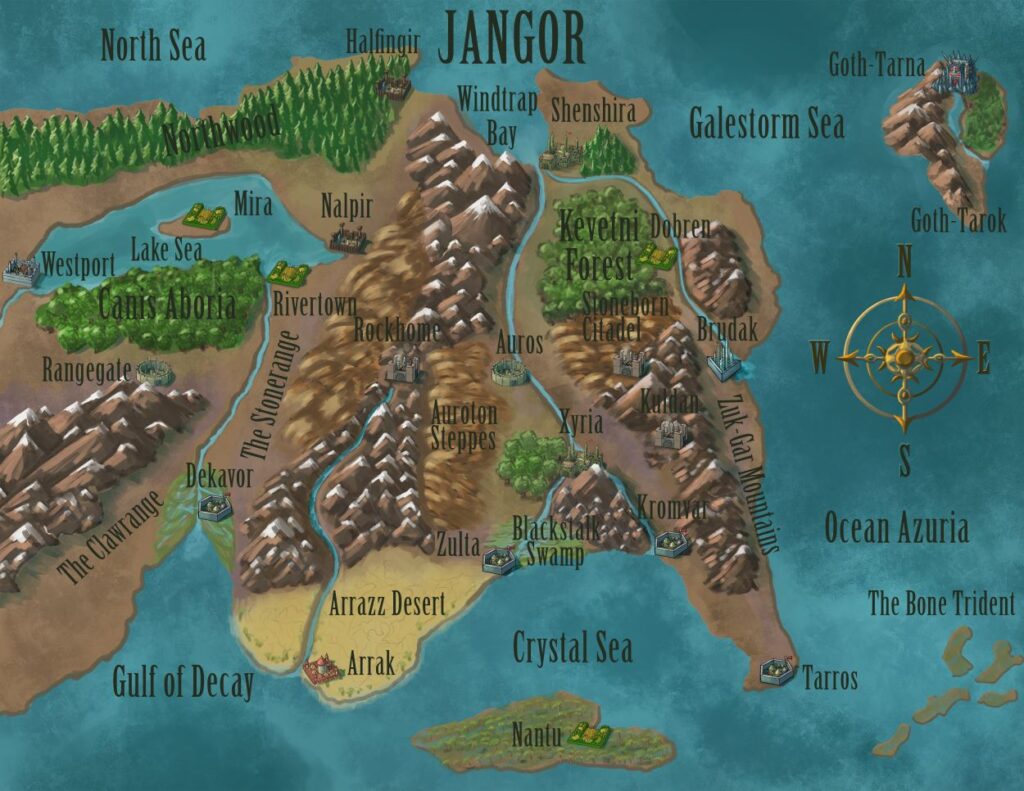

Lytharian Chess is a strategic fantasy game for 2 players that is played on a special chess board. You are in command of an army of troops equipped with weapons of war and a wide array of spells. The goal is to defeat your enemy’s king. What makes this experience unique is that your troop cards are pieces that are moved around the board. Planning your troop movements will be key to your victory. Damage is persistent so managing your army’s healing and potential combat attrition are foremost to winning. Mana is steady and consistent with ways to access more in an emergency through mana harnessing, reforging and playing cards. This game effortlessly combines the aspects of a board game and a card game with the added layer of chess like movement and a few dice rolls thrown in for some luck elements.

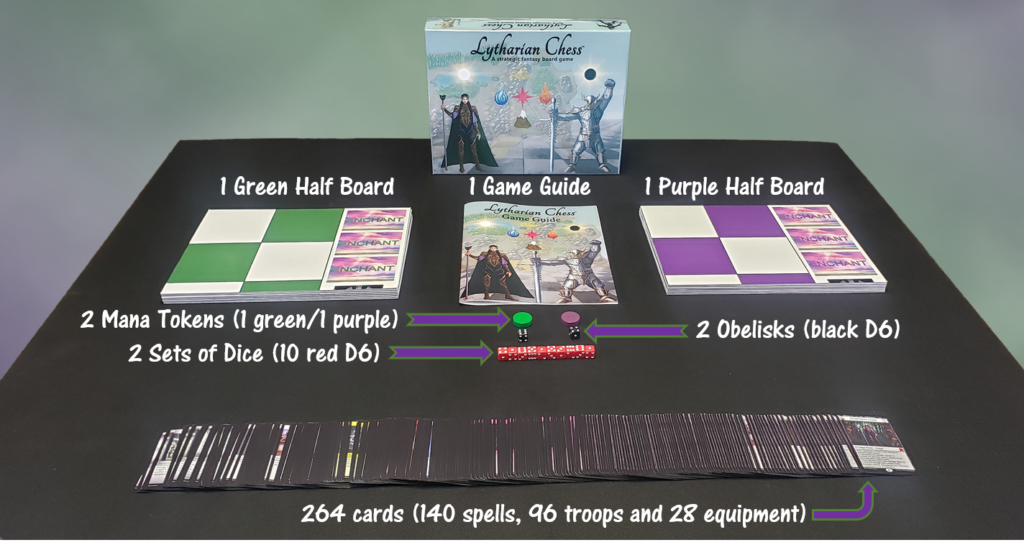

The play area of the game board is similar to a chess board. The diagram below shows how the 2 half boards are set up slightly offset. There are 64 squares on the board alternating between 1 white square and 1 colored square. The castle area is the 2 squares initially occupied by the king and queen. Each player has a space to draw cards, a crypt space for troops that have been killed, a nether space for spells/equipment to be discarded and 3 spaces for placing enchant spells that are cast during game play. On each side of the board is a mana counter that goes from 1-15 and ends with an obelisk space. A black D6 (obelisk) is used to show how many base points of mana are gained each turn in the mana phase.
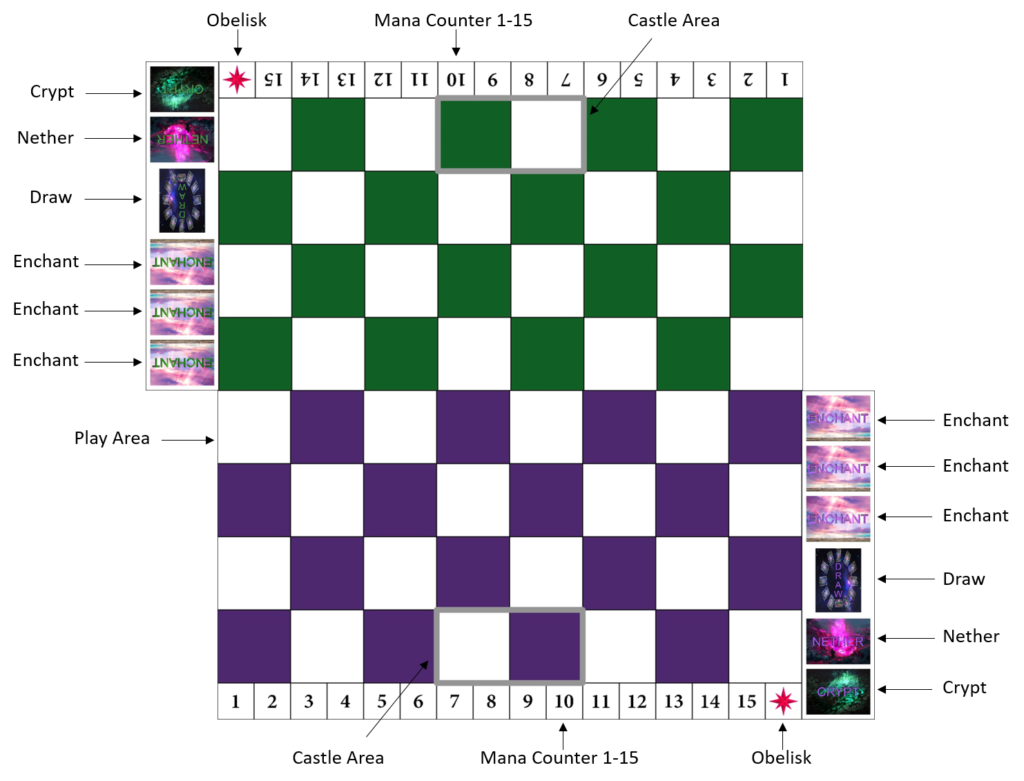


Troops represent traditional chess pieces and include the K (king), Q (queen), R (rook), KN (knight), B (bishop) and P (pawn). Troops have different levels of attack power, defense power and special abilities used during battle. There are good troops, evil troops and neutral troops.
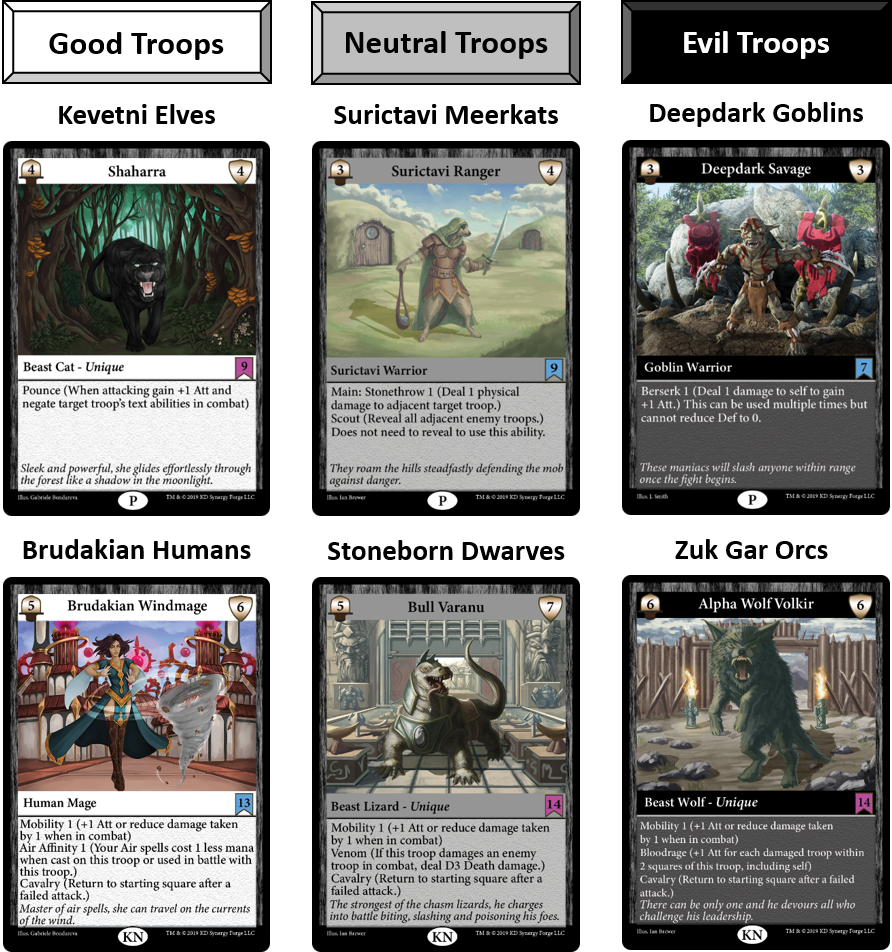

Players will use spells of different alignments, elements and arcane to win their battles.
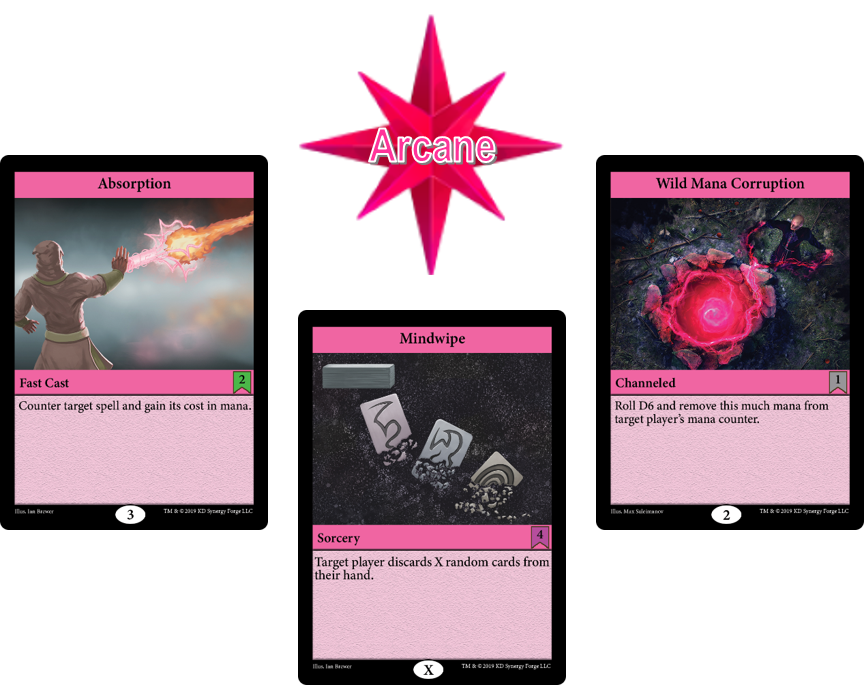
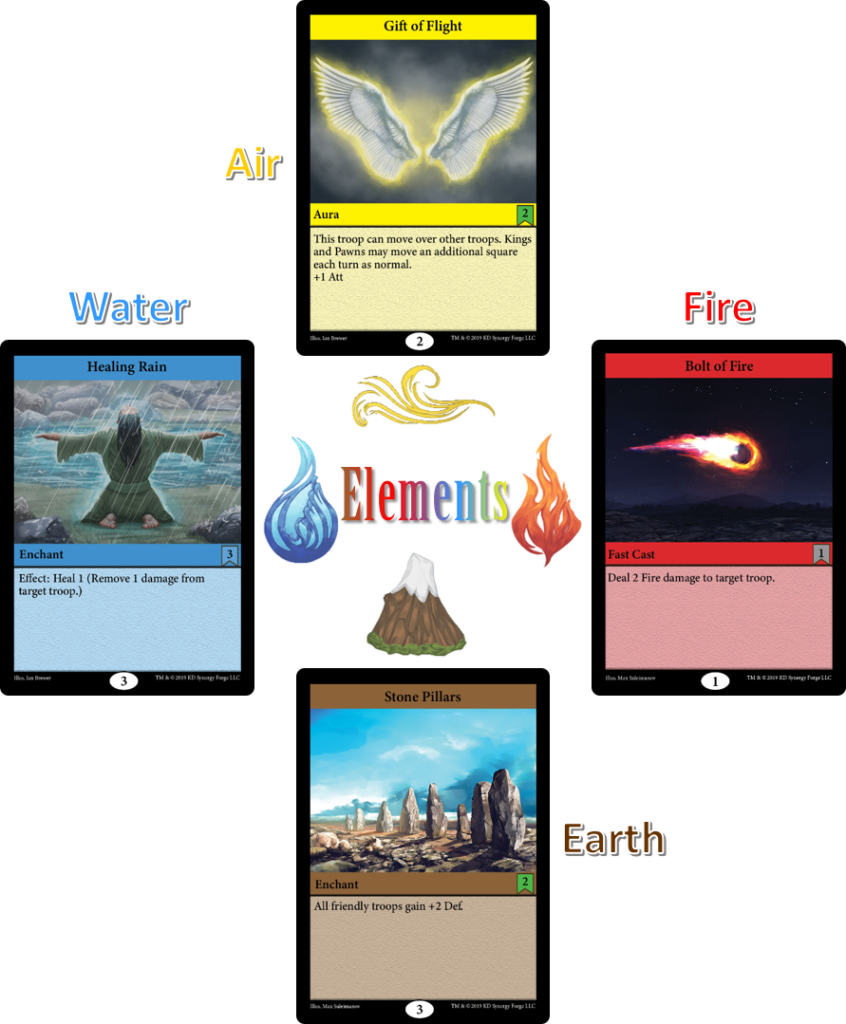


There are two types of equipment players can attach to humanoid troops to increase their attack and/or defense power. Weapons increase attack power and armor increases defense power. Our equipment cards have a special layout that allows you to see their name and Att/Def when attached underneath a troop. In the example below, with both the Longsword and Plate Mail equipped, Battle Brawler Bronn is effectively a 13 Att/14 Def troop.
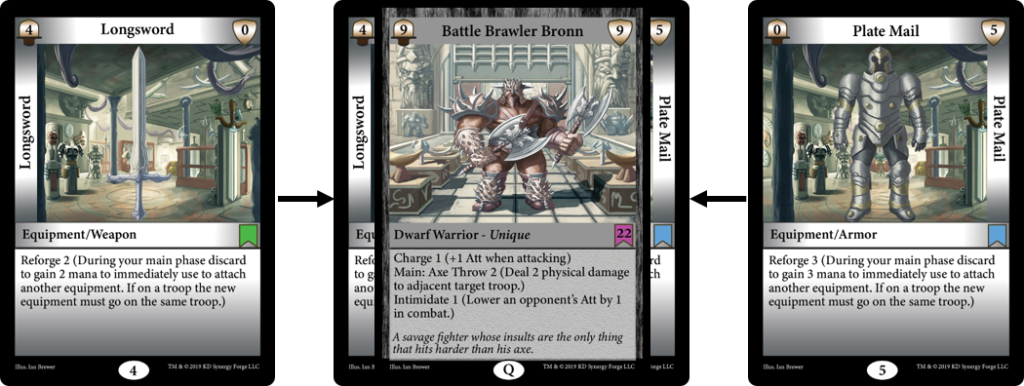

Troops– To start the game, each player chooses 16 troops for their army. The army will consist of 1 King, 1 Queen, 2 Rooks, 2 Knights, 2 Bishops and 8 Pawns. No more than 2 of the same type of troop may be used for Pawns. No more than 1 of each troop with the unique trait can be used. Good troops and evil troops cannot be used in the same army.
Army Power Score – Players will add up the power scores for all of their troops to determine their army power score. The lower army power score is subtracted from the higher and then divided by 5 rounding up. This is the bonus mana the player with the lower army power score starts with and this player goes first. If both power scores are the same each player rolls a D6 and the higher number goes first. If this roll is a tie, repeat until there is a clear winner.
Spells/Equipment – After choosing troops players will select a minimum of 50 spells/ equipment for their deck. No more than 3 of the same spells/equipment may be used. Elemental opposite spells may not be used together. Evil armies may not use life spells and good armies may not use death spells. Neutral armies can use life or death spells but only one or the other, not both at the same time. Any army can use arcane spells.

The board is laid out similar to a chess board but uses cards instead of chess pieces. The player who goes first (Player 1) places the bottom row from left to right as follows: rook, knight, bishop, queen, king, bishop, knight, rook. In the row above these cards, 8 pawns are arranged in any order. Player 2 is exactly the same except the queen is placed in the dark square of the castle and the king in the white square of the castle. Each player will shuffle their spells/equipment and allow their opponent to cut the deck. Each player will place their deck in their respective draw space. The mana token will be placed in the square numbered 1 in the mana counter. The obelisk die will be set in its space and set to 1. Players begin the game with no cards in hand.
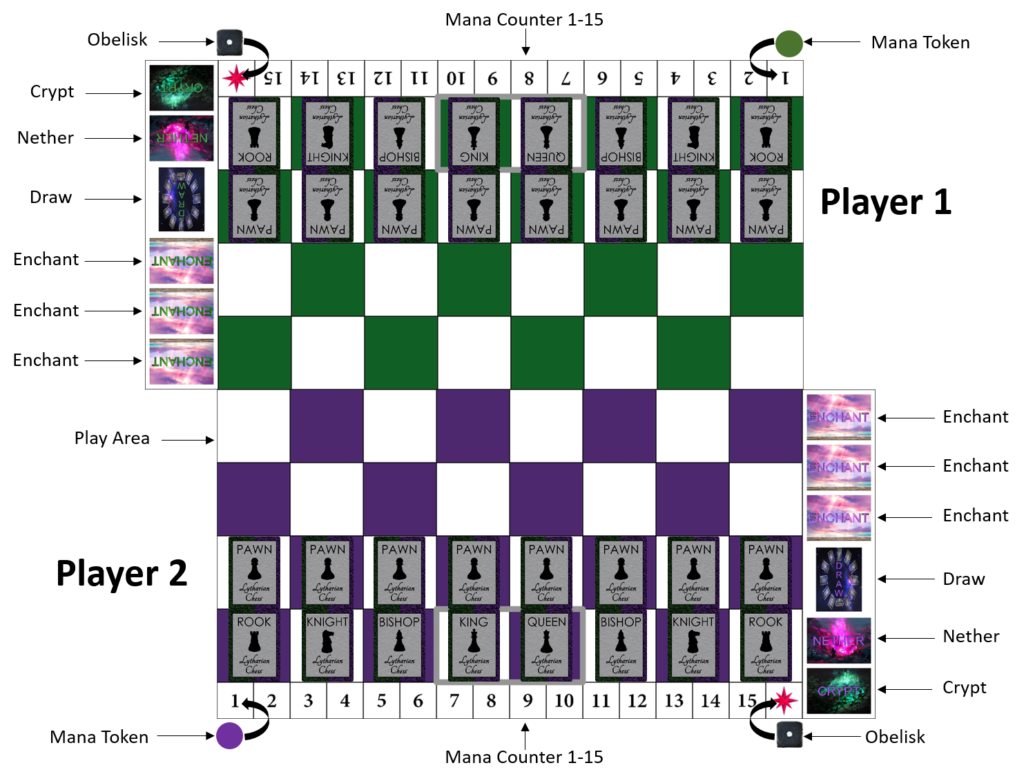

King – The King can move 1 square only in any direction.
Queen – The Queen can move in any one direction as many squares as possible as long as they are empty.
Rook – The Rook can move either forward, backwards, left or right as many squares as possible in one direction as long as they are empty.
Knight – The Knight moves in an L pattern, either 1 square forward and 2 squares left or right or 2 squares forward and 1 square left or right. The Knight is the only piece that can jump over other pieces.
Bishop – The Bishop can move diagonally as many squares as possible in one direction as long as they are empty.
Pawn – The Pawn can move 1 square straight forward as long as it is empty. On its first move, a pawn can move 2 squares straight forward as long as they are empty. The Pawn can never move backwards. The Pawn attacks in a forward diagonal direction.
Pawn Promotion – If the Pawn reaches the other side of the board, it can be transformed into a copy of any friendly troop (even a unique troop), except for the King. They will lose all attached equipment, spells and damage upon promotion. You may use a piece of paper to represent the troop it is duplicating and fill in the relevant statistics or click here to download a printable sheet of token cards. We recommend printing on card stock, however regular copy paper is fine.
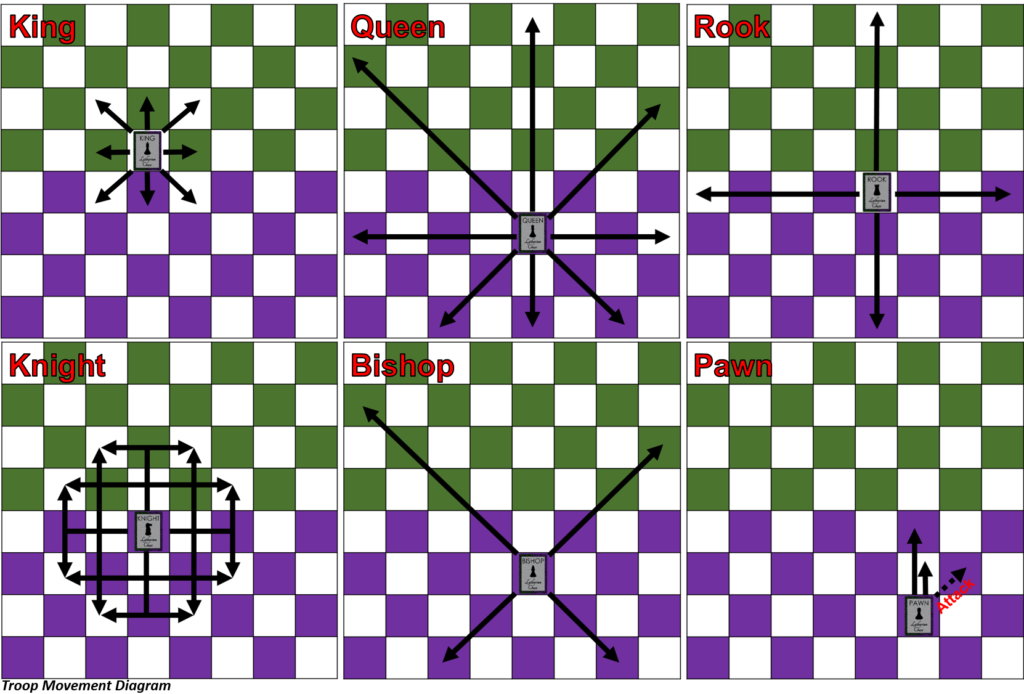

In order to initiate an attack the active player’s troop must be adjacent to an enemy troop or move adjacent to an enemy troop and can only attack in the direction they can move (except for pawns). The active player can attack and then move any piece or move a troop adjacent to an enemy and attack. If an attack is started from an adjacent square this does not count as a movement. A basic attack compares both troop’s Att vs the other troop’s Def. If a troop’s Def is reduced to zero or below it is killed. Unless otherwise stated all troops inflict physical damage during combat. If an attack is successful the defender is removed from the board and the attacking troop occupies the defender’s square. If an attack is unsuccessful and both troops survive the attacker remains in the square they started in if they were stationary or the last square they moved to before initiating the attack. When a troop takes damage a D6 is placed on the troop displaying the amount of damage they have taken.

To cast a spell a player must first pay its mana cost (this is instantaneous and uninterruptable). Once this cost is paid and a spell is cast your opponent is given a chance to respond. If they elect to pass then this spell resolves. If they respond then this process repeats until both players pass. Spells resolve in the order of last back to first. This process can be repeated until mana is depleted and non-permanent spells are placed in the player who cast the spell’s Nether. If your mana drops to zero, remove your mana token from the board and place it on top of your deck until you gain more mana. If a troop leaves the square they were in when targeted by spell(s) before they resolve, those spells have no effect (because they no longer have a target) and are placed in the nether.

Once per turn a player may discard a spell from their hand to gain mana based on the discarded spell’s quality. This mana must be used immediately to cast only spells and any unused mana is lost. This mana can be used to cast multiple spells and can be used in conjunction with mana from your counter to cast a higher cost spell.

Equipment is not a spell but is paid for with mana. Equipment is attached underneath troops with weapons displayed on the left and armor displayed on the right to show the name and Att/Def value they add to the troop. Equipment can only be attached to a troop by the active player during their main phase on troops they control. Equipment will remain with the troop unless the opponent removes it, it is reforged into a different piece of equipment or the troop is killed. Equipment may only be attached to humanoid creatures. They may not be attached on beasts, elementals or monsters.

During their main phase, a player may discard an equipment card from their hand to gain mana equal to its reforge value to immediately use to attach equipment to a troop. If an equipment is already attached to a troop it can be discarded to gain mana equal to its reforge value to immediately attach another equipment on the same troop. You may reforge multiple times during your main phase and multiple pieces of equipment may be reforged to attach a higher cost piece of equipment. In addition, reforging can be used in conjunction with mana from your counter to attach a high cost piece of equipment.

1. Effects Phase – The active player will begin the turn by any effects on the board taking place. Example: decreasing the damage on any troop that is being healed by a bishop. A troop must reveal to use an effect unless stated otherwise on their card. The active player is responsible for their effects triggering and if they end the phase without using an effect there is no going back. If a card has more than one effect, they can each trigger once per effects phase. The active player decides what order multiple effects happen in this phase.
2. Mana Phase – At the start of this phase the active player will advance their mana counter 1 space or more depending on spells, abilities or powering up their obelisk. If at any point during the game your mana reaches 15 you can choose to charge your obelisk and reset your mana to 1. Doing this increases your per turn mana base by +1 up to 6 per turn maximum. The obelisk die is rotated accordingly.
3. Draw Phase – The active player will draw a card. A player’s base maximum hand size is 10. Cards and effects may allow a player to have more than 10 cards in hand. If the player already has 10 or more cards, they can choose to discard down to 9 cards in order to draw a card or play fast cast spells to get down to 9 cards and then draw. The active player can choose not to draw and keep the 10 or more cards they have in hand and move on to the main phase. Any time a player accidentally draws more cards than they need and looks at them, they must put the extra card(s) back, shuffle and allow their opponent to cut the deck.
4. Main Phase – During this phase, the active player can do the following actions in any order:
- Cast Spells – The active player may cast any type and number of spells limited by their mana. The defending player may cast fast cast spells during this phase.
- Move – The active player must move a troop every turn.
- Attack – If the active player attacks first and takes an adjacent square through victory this does not count as movement and they must still move a troop this turn or they can move and attack a troop as normal, however only one attack per turn is allowed.
- Main: Abilities – The active player’s troops must reveal in order to use these abilities. Multiple troops can use them, however they can only be used once per troop per turn. A troop may attack or use its main: ability, but not both. If a troop has more than one main: ability, they can each trigger once per main phase. The active player decides what order multiple main: abilities happen in this phase.

The game is won when one of the following happens:
1. The enemy king is defeated.
2. If both kings kill each other and there are other troops on the board, the player with the highest total power score of troops on the board wins.
3. If one player’s army is destroyed to the point where they only have a king left, they must perform an honor charge. They must advance their king directly towards the enemy king to attack them. They must engage other troops directly blocking them. They can play spells and effects that enable them to end their turn without moving but none that allow them to move backwards. If they defeat the enemy king and survive they win.
4. If both players only have a king left on the board, they must both perform an honor charge. If they kill each other the winner is determined by adding up the power scores of all the troops they killed. The player with the higher total wins. If this total is equal, the player with the lowest total army power score wins. If the total power score of both player’s armies is the same, roll D6 and the highest roll determines the winner. If rolling results in a tie, continue rolling until someone wins.

1. Normal Chess – Play a standard game of Chess with your favorite cards face up or face down.
2. Battle Duels – This mini game is a good way to test the capabilities of troops and spells. The strategy element comes in the form of troop and spell selection and the order they are played. Using a smaller deck, having full mana and a full hand of cards ensures battles with many interactions.
Game Play – There will be 7 rounds in which the opponents alternate who is the attacker and defender. A player wins the round by defeating the opponent’s troop with their troop surviving. If both troops are killed, the player with the lower power score troop wins the round. If the troops have the same power score then it is a tie. This process repeats until a player wins 4 rounds. In the very unlikely event of 7 ties, the players should randomly select a troop from the 7 they picked (without looking) and play until someone wins a round. Players use their obelisk to keep track of wins and 4 wins takes the match.
3. Pawn Wars – In this alternate game, players fight with an army of pawns to achieve victory, using only the “little guys”.
Game Play – The game is played normally and the object is to get your Pawns to the other side of the board. When you get a Pawn to the other side, instead of promotion, they are removed from the board and you gain 1 point (use a D6 to keep track of points). When a pawn reaches the other side of the board through combat, they must survive in order to gain a point. The player with the most points wins. In the event of a tie, the players compare the power score of the Pawns they killed and the higher point total wins.

Signup for our Newsletter!
We respect your privacy.
